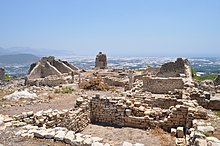Rhodiapolis
Ῥοδιάπολις (in Greek) | |
 The ruins of Rhodiapolis lie on a hill west of modern Kumluca, which is visible in the background. | |
 Shown within Turkey | |
| Alternative name | Rhodia, Rhodiopolis |
|---|---|
| Location | Kumluca, Antalya Province, Turkey |
| Region | Lycia |
| Coordinates | 36°23′13″N 30°15′56″E / 36.38694°N 30.26556°ECoordinates: 36°23′13″N 30°15′56″E / 36.38694°N 30.26556°E |
| Type | Settlement |
| History | |
| Builder | Probably Rhodian colonists |
| Associated with | Opramoas |
Rhodiapolis (Ancient Greek: Ῥοδιάπολις), also known as Rhodia (Ῥοδία) and Rhodiopolis (Ῥοδιόπολις), was a city in ancient Lycia. Today it is located on a hill northwest of the modern town Kumluca in Antalya Province, Turkey.
History[]
It is called Rhodia by Ptolemy (V, 3) and Stephanus Byzantius; Rhodiapolis on its coins and inscriptions; Rhodiopolis by Pliny the Elder,[1] who locates it in the mountains to the north of Corydalla. The city was considered to have been founded by colonists from Rhodes; the name Rhodiapolis means Rhodian City in English.[2]
Not much is known of the history of Rhodiapolis. It was a relatively small city in the Lycian League with only one vote, but did have the right to mint coins. A notable amount of silver coins produced in Rhodiapolis have been found.
In the Roman period the city became famous for being the home of the millionaire philanthropist Opramoas. A monument was constructed in his memory close to the city's theater. On the monument's walls is the longest inscription in Lycia, commemorating his benefactions and the numerous honors bestowed on him. According to these, Opramoas donated approximately 500,000 denarii to twenty-eight cities in Lycia to repair the damage caused by an earthquake between 140 and 143 AD. He also funded the construction of two temples at Rhodiapolis. Heraclitus was another famous resident, known for his oratory and knowledge of medicine.
According to inscriptions the city was a center for the cult of Athena Polias during the Hellenistic and Roman period.[2]
Ecclesiastical history[]
Rhodiapolis was in the late Roman province of Lycia and so its episcopal see was a suffragan of Myra, the metropolitan see of that province. Only one bishop of Rhodiapolis is known, Nicholas, present in 518 at a .[3] The Notitiae episcopatuum continue to mention the see as late as the 12th or 13th century.
Excavation history[]
The city was discovered in 1842 by T. A. B. Spratt. The first visual documentation and detailed investigations of the Opramoas inscriptions were completed by a team led by E. Krickl in 1894. The site was damaged by a large forest fire in 2005. The first excavation campaign at Rhodiapolis was conducted in 2006 on behalf of the Ministry of Culture and Tourism and Akdeniz University under the leadership of Nevzat Çevik.[4]
The site today[]
The remains of an aqueduct, a small theater, a temple of Asclepius, sarcophagi, and churches are still visible on the site. In 2011 a Lycian cemetery complex was discovered, dating from approximately 300 BC.[5]
Rhodiapolis is one of the pilot sites for the European Union FP7 project called FIRESENSE. In 2010, several cameras and a wireless sensor network were installed at the site and its surroundings by the Electrical and Electronics Engineering Department at Bilkent University. Using this system, wildfires and floods can be automatically detected at the site and its surroundings. The main purpose of the system is to protect this ancient site from natural disasters. It is also possible to remotely monitor the site 24/7, thereby preventing theft and illegal excavations.[6][7]
Gallery[]
Theater
Theater
Lycian sarcophagus
Funerary monument of Opramoas
References[]
- ^ Pliny the Elder, Natural History 5.28
- ^ Jump up to: a b Murphey, Dennis (2006). "The Cisterns and Reservoirs of Rhodiapolis, Southwest-Turkey: A Study in Ancient Water Management". In Wiplinger, Gilbert (ed.). Cura Aquarum in Ephesus: Proceedings of the Twelfth International Congress on the History of Water Management and Hydraulic Engineering in the Mediterranean Region, Ephesus/Selçuk, Turkey, October 2-10, 2004 (PDF). Babesch Supplements: Annual Papers on Mediterranean Archaeology. 12. Leuven: Peeters. pp. 159–164. ISBN 9789042918290.
- ^ Pétridès, S. (1912). "Rhodiopolis". The Catholic Encyclopedia. New York: Robert Appleton Company. Retrieved 11 April 2013.
- ^ Çevik, Nevzat; Kızgut, İsa; Süleyman, Bulut (2007). "Excavations at Rhodiapolis in 2006: The First Campaign" (PDF). Kazi Raporlari. 5: 59–67.
- ^ Aktaş, Cihan (17 October 2011). "Archaeologists uncover Lycian tomb complex in Turkey". World Bulletin. Retrieved 11 April 2013.
- ^ "Article about FIRESENSE in Turkish newspaper "Hurriyet"". The FIRESENSE Project. Retrieved 11 April 2013.
- ^ "Rhodiapolis, Antalya (Turkey)". The FIRESENSE Project. Retrieved 11 April 2013.
Further reading[]
- Akyürek, Engin; Tiryaki, Ayça (2010). "Remarks on Three Pieces of Architectural Sculpture from the Excavations at the Rhodiapolis Episcopal Church". Adalya (in Turkish and English). 13: 389–404.
- Çevik, Nevzat; Kızgut, İsa; Süleyman, Bulut (2010). "Rhodiapolis, as a Unique Example of Lycian Urbanism". Adalya. 13: 29–64.
- Çevik, Nevzat; Kızgut, İsa; Süleyman, Bulut (2009). "Rhodiapolis Baths: The First Evaluation Following the Excavations and its Contribution to the Knowledge on Lycian Baths Architecture and Technique". Adalya. 12: 231–260.
- Duggan, T. Mikail P. (4 October 2008). "The summer excavations at the ancient Lycian city of Rhodiapolis". Turkish Daily News. Retrieved 18 May 2013.
External links[]
| Wikimedia Commons has media related to Rhodiapolis. |
- Ancient Greek archaeological sites in Turkey
- Archaeological sites in Antalya Province
- Former populated places in Turkey
- Populated places in ancient Lycia
- Roman sites in Turkey
- Catholic titular sees in Asia
- Kumluca District




